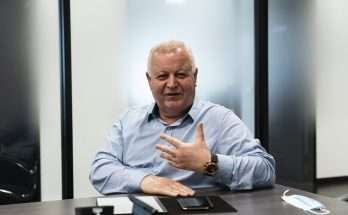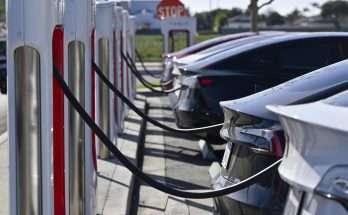American Airlines jet parked at LaGuardia International Airport in New York.
Adam Jeffery | CNBC
In 1928, one person crossed the Atlantic; in 2018 there were 4.3 billion passenger journeys recorded. Although some people managed to avoid it even before Covid – according to a Gallup poll, about half of Americans don’t fly at all — the rest of the U.S. population flies enough to bring the mean up to about two flights per year.
It takes a lot of energy to get people up into the air and, since the production of energy comes at an environmental cost, air travel is a significant carbon emitter, with a unique challenge compared to other modes of transport when it comes to climate change. Unlike innovations in electric cars, boats, and trains — where the added mass required to go electric isn’t an insurmountable engineering problem, and the extension cords aren’t 30,000 feet long — combustible fuel remains largely the only way to fly, at least for longer flights. Eighty percent of emissions are from flights that are roughly 1,000 miles or longer, and for which there is no current viable alternative to fuel.
Each individual has a role to play in bringing down emissions. The average American is responsible for about 15 metric tons of CO2 per year, and more than one-third of Americans say they now are likely to pay a little extra in their airfare for carbon offsets. The rich and famous have an even bigger carbon footprint. Taylor Swift’s much-maligned private jet produces around 8000 metric tons of CO2 annually. But Taylor has nothing on the airline industry, whose annual CO2 emission is pushing one billion metric tons. If the combined air industry were a country, besides having a killer peanut region, it would also have a larger CO2 emission than Germany.
The industry, though, stresses its small carbon footprint relative to other industries.
U.S. carriers, specifically, transport over 2 million passengers and 68,000 tons of cargo per day while contributing “just” 2 percent of the nation’s greenhouse gas emissions, according to the industry trade group Airlines for America. The aviation industry has become more efficient in recent decades, with U.S. airlines improving their fuel efficiency (on a revenue ton mile basis) by more than 135% between 1978 and 2021. But a focus on how low that 2% figure seems is part of a growing problem, according to climate analysts who study the aviation sector.
Covid slowed air travel, but it’s still expected to triple
Video conferencing may replace some portion of business travel, but as the aviation sector rebounds, climate analysts say a tripling in global air travel in the decades ahead — although forecast before Covid — is still a safe bet. Passenger travel will ramp back up more slowly, but analysts note that aviation is also used for cargo, which is not effected by business class. That’s a reason for significant concern about aviation’s carbon reduction plans. The industry needs to be focused on keeping its share of emissions down, rather than seeing its current share as a reason to move more deliberately, according to climate analysts.
Compared with autos, where there is already a decade of progress on electric vehicles, and in the power generation sector, where there have already been significant investments in renewable energy sources that are cost-competitive versus traditional sources, aviation is still in the experimentation days of new fuel technology. Electric batteries, at best, have a role to play on shorter, regional routes and urban travel, and airlines are making these investments.
Some critics say the aviation industry has been too slow to seek climate solutions, but concede that aviation is a tough sector when it comes to net-zero goals because of its unique safety and regulatory requirements. Aviation wasn’t helped by the pandemic, and even its critics say that expecting the past few years to have seen a tidal wave of investment into startup technologies would have been unrealistic given the more pressing financial challenges. Airlines have completed test flights with sustainable aviation fuels, and the deals with sustainable aviation fuel producers have started to accumulate.
Travelers make their way through security check at San Francisco International airpot during the start of the long July 4th holiday weekend in San Francisco, California, June, 30, 2022.
Carlos Barria | Reuters
American Airlines finalized a deal over the summer with biofuel company Gevo to purchase 500 million gallons of sustainable airline fuel (SAF) over five years, part of American’s net zero carbon directive. It describes its climate goals as “aggressive,” including achieving net-zero greenhouse gas (GHG) emissions by 2050. American is the first airline globally to receive validation from the Science Based Targets initiative for its intermediate GHG emissions reduction targets and the only U.S. airline to report using more than 1 million gallons of sustainable aviation fuel in 2021.
Gevo’s process for producing low or zero carbon SAF starts at the farm where feedstock is grown. The company partners with farms that use regenerative agriculture techniques which sequester carbon in the soil. These farms also use precision application of chemicals and fertilizers to reduce the carbon footprint in that process.
The plants that Gevo is designing will take those feedstocks (i.e., field corn) and convert it to ethanol. From ethanol, Gevo then processes further into a product that is chemically identical to standard aviation fuel. The difference between standard aviation fuel and Gevo’s SAF is the elimination of any fossil fuels being used in that production process for heat, electricity or any power needed.
Instead Gevo’s integrates wind, solar, hydrogen, biogas, and other sources of renewable energy to eliminate fossil fuels from the process. This will provide a replacement fuel for aviation needs that is net zero, or even net negative, in terms of carbon intensity if carbon capture, utilization and storage (CCUS) is integrated as well, according to John Richardson, director of investor relations at Gevo.

SAFs are chemically indistinguishable from standard airline fuel – but their production process is significantly different (and greener) than traditional fuels — though unlike EVs in the auto sector, there is much debate about which SAF approaches will be the ultimate winners, and what tradeoffs need to be made today to support current technologies in development.
The Gevo approach, focused on feedstocks, is a good example.
Today, feedstocks that go into sustainable aviation fuels are not produced at a scale that is anywhere close to global jet fuel, and that scaling issue will remain for years as competing technology approaches are tested by the aviation industry. Using feedstocks from food production, specifically, may become a larger issue from an optics perspective in the future.
Several climate analysts told CNBC they are concerned about too much focus on scaling feedstock-based sustainable jet fuels at a time of growing concerns about global food security in a world facing major climate change impacts on agriculture. Gevo stresses that it uses residual starches from “inedible field corn” as feedstock, which are abundant in supply and low in nutritional value.
Airbus CEO Guillaume Faury conveyed the matter at a panel at Britain’s Farnborough International Airshow – a five-day exhibition where executives and key figures gather to discuss the future of air travel: “Probably in the long run — in many decades — we will find a very optimized way of sustainable energy but in the transition, the fast way is to use the SAF, and they are available now,” he said.
Judged against the standards of its own industry, American remains a leader in carbon reduction efforts. American received a CDP Climate Change score of “A–” in 2021 — the highest score among airlines in North America, and one of only two airlines globally to score that high.
“We recognize that climate change is urgent and imminent” said Jill Blickstein, vice president of sustainability at American Airlines. “As the world’s largest airline, American is committed to developing the tools necessary to decarbonize our operations.”
In addition to Gevo, it has invested in Bill Gates’ Breakthrough Energy Catalyst, “all aimed at bringing forward the technologies that will help reach our ambitious sustainability goals,” Blickstein said.
Decarbonizing airplanes gets boost from Biden
There are multiple technological approaches to sustainable aviation fuels that can decarbonize planes without prolonging the use and dependence on current fossil fuels and green hydrogen technology just got a big boost from the Inflation Reduction Act.
More investor money is expected to flow into green hydrogen as a result of the IRA, with climate analysts describing the tax credits as being a huge driver for sustainable aviation fuels because science aside, the biggest challenge with scaling up these operations and SAF production has been the financial incentive. Green hydrogen approaches aim to remove C02 from the air and blend it with green hydrogen into a form of kerosene that can be cost competitive with convention jet fuel. In February 2021, KLM first flew a Boeing 737 passenger plane from Amsterdam to Madrid fueled with 500 liters of synthetic kerosene, from energy giant Shell, mixed with traditional jet fuel.
Recently announced deals with startups in the space were already in the works with major air carriers even before the IRA, including Twelve, which recently inked a deal with Alaska Airlines and Microsoft for its approach to create sustainable fuels using carbon captured from the air, water and renewable energy. Alaska, which has used SAF blends since 2011 on specific routes, noted itself there is a long way to go: currently less than 1% of total fuel available is SAF, and its costs is three to five times more than conventional jet fuel.
Delta Air Lines recently signed the largest U.S. aviation deal yet for green hydrogen produced fuels, with Louisiana-based DG Fuels, which uses waste CO2 as a feedstock, and in its announcement measured the scope of the challenge ahead by stating that the existing global SAF supply could operate a fleet Delta’s size for one day.
For the time being, EVs are much father along the innovation curve, with many more years of testing and government policies to support the transport sector’s transformational growth.
But not everyone sees SAFs as the solution, particularly given growth trends in the industry. At the recent Farnborough International Airshow, campaigners and climate activists pushed back against the industry’s emphasis on SAFs, urging them to “get real” and offer more significant climate solutions. Instead of SAFs, slowed growth and less travel and fewer flights is proposed as a way of addressing the issue, perhaps by reducing domestic flights and encouraging and improving rail travel.
Analysts caution that all of the effort going into aviation’s carbon-free future should not eliminate even more significant replacements for air travel, such as high-speed rail. But for aviation, the goal has to be the same as in other sectors, with its emissions peaking as soon as possible. And the choice that seems clear today is that aviation remains on the fuels pathway, unlike autos, where electric is the future. Whichever form of fuel production produces the least emissions with the greatest benefit and cost-effectiveness will win, and that’s what no player in aviation knows for certain today. Climate analysts expect it will take at least five years to a decade for the most viable solutions to emerge.


